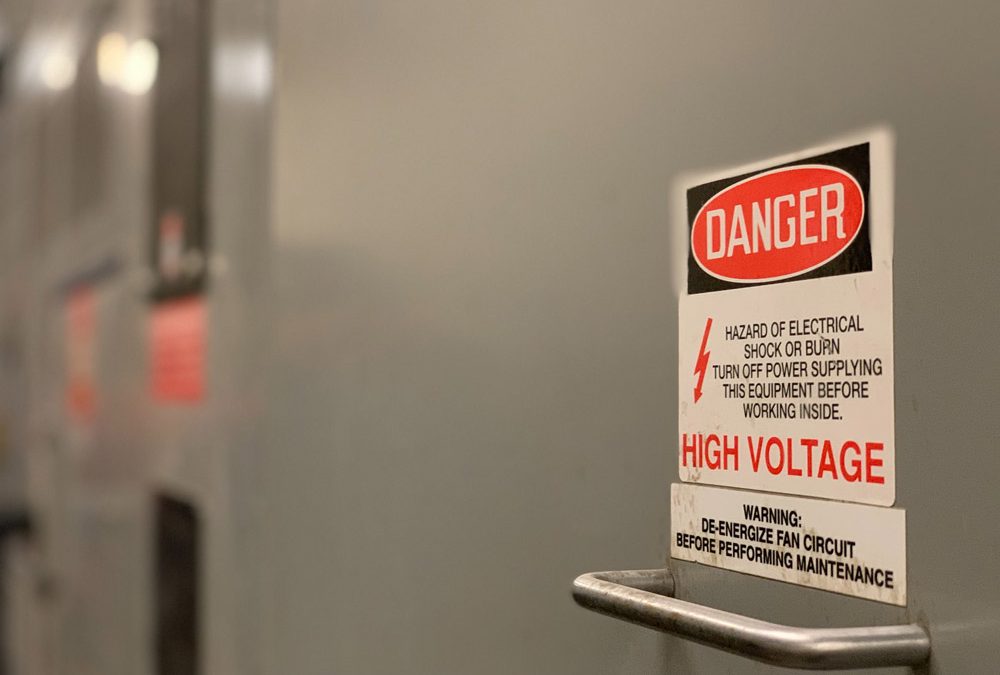Today, any office or workplace setting operates on electricity. Electrical equipment, from computers to machinery can all be potentially hazardous and can cause shock and burn injuries if improperly used or maintained. Though most general personnel don’t need specialized electrical safety training, if you work around electricity, but are not qualified to directly handle electrical components, it’s important to follow electrical safety-related work practices to keep yourself and others safe. Here are 10 electrical safety tips for the workplace to help you avoid electrical hazards:
01. PREVENT ALL POTENTIAL CONTACT WITH LIVE ELECTRICAL CURRENT
The best way to stay safe is to stay away from electrical hazards. Unqualified personnel should not interact or come close to electrical currents greater than 50V. If you must work in the same area or room as an electrical hazard or equipment operating on more than 50V, maintain a safe distance. All panel doors should be shut, and there should be no exposed wires around your work area before you begin your operations.
02. DE-ENERGIZE EQUIPMENT AND USE LOCKOUT/TAGOUT
Exposed, live electrical parts must be de-energized before work on or near them is permitted. Prevent accidents and isolate electrical energy by locking and tagging out the electrical system or parts of the system according to your company’s Lockout/Tagout policy.
Lockout/Tagout exists to protect employees from electrical hazards while performing servicing and maintenance activities. Learn more in our article: What is Lockout/Tagout?
For more in-depth information about implementing proper Lockout/Tagout procedures in your facility, you may be interested in eSafety’s Lockout/Tagout course.
03. ENSURE SAFE USE OF ELECTRICAL EQUIPMENT
Properly using all electrical equipment can go a long way to ensure everyone’s safety in the workplace.
Employees should take care to handle electrical cords properly:
- Always unplug cords by pulling on the plug head, rather than the cord
- Don’t press or overstretch electrical cords
- Don’t fasten cords with staples
- Don’t hang electrical equipment from cords
Additionally, all cords and plugs in the workplace should be visually inspected for external defects prior to use. If you encounter a cord or plug with damage, do not use that equipment.
04. INSTALL PROPER PHYSICAL BARRIERS AROUND ELECTRICAL HAZARDS
Physical barriers should always be used to protect employees from any electrical hazards. Cabinet doors on electrical panels should always be closed, and panels should not have holes where an employee could come into contact with exposed wires.
If cabinets cannot be closed, or if an electrical hazard cannot be fully closed in, shields, barriers, or insulating materials should be used.
For example, if a qualified electrician is performing maintenance on an electrical panel and must keep the panel open, physical barriers should be put in place to prevent others from entering the area. Signs should be placed to warn employees of the hazard, and the area in front of the electrical panel should be kept free of any obstructions.
05. BEWARE OF CONDUCTIVE TOOLS AND CLEANING MATERIALS
If you are working in an area where an electrical hazard is present, always assume that electrical parts are live, and act accordingly. Do not use conductive tools in the area.
If you are cleaning the area, note that some cleaning materials are conductive as well and require additional caution. Solvent and water-based cleaning materials are electrically conductive, as are steel wool and metalized cloth. Keep these cleaning products, as well as any conductive tools, away from live electrical parts and equipment.
06. WHEN WORKING OVERHEAD, LOOK ABOVE FOR ELECTRICAL LINES
When performing any work or maintenance overhead, beware of electrical lines. In most workplaces, there is the potential for live electrical equipment and parts above the floor level, which are only accessible with ladders or elevated platforms. Be sure to use a portable ladder with non-conductive side rails, and stay at least 10 feet away from any exposed electrical lines while you are performing overhead work.
07. USE EXTREME CAUTION WITH FLAMMABLE MATERIALS
Electrical equipment that can cause ignition must not be used where flammable vapors, gases, or dust are present. The only exception to this rule is when qualified personnel take measures to lockout and isolate electrical energy sources before these potentially flammable materials may be used or the electrical equipment is designed for use under these types of conditions.
08. ONLY QUALIFIED PERSONNEL SHOULD WORK ON LIVE ELECTRICAL WIRES
If you encounter a live electrical wire, stay away. Only qualified personnel with the proper training should work on live electrical wires. The same electrical safety precaution applies to hazardous electrical equipment. Any live electrical hazard should only be approached and managed by qualified personnel. If you see a live electrical wire that is not attended, you should notify the appropriate electrical safety personnel, who should immediately place physical safety barriers.
09. ALWAYS FOLLOW YOUR COMPANY’S ELECTRICAL SAFETY WORK PRACTICES
Every company has unique electrical safety work practices depending on the electrical equipment and hazards present in your industry and workplace. It is important to always follow your company’s specific electrical safety work practices to keep yourself, and other employees safe.
10. ELECTRICAL SHOCK CAN BE DEADLY
In every situation, treat an electrical part as if it is live. Electrically live parts do not look different from de-energized parts. To ensure safety, it’s best to assume that any electrical part is live. Take precautions to keep power on its path, and protect yourself. You can’t be too careful when it comes to electricity.

No comments:
Post a Comment